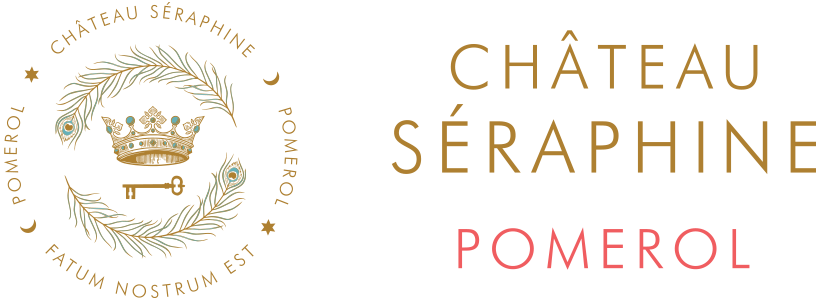Château Séraphine 2019
“Velvety black-purple red with deep purple rim, immediately rich and ripe on the nose, black summer fruits, nicely concentrated cassis with exotic spice/camphor elements, same natural richness of fruit on the palate with superb purity of expression and nothing exaggerated, just pure vineyard Merlot, will be a sumptuous and classy Pomerol, tannins are very well managed.”
— Steven Spurrier
“Richly flavoured, velvety textured and multi-layered with smooth dark plum blackberry raspberry fruits, fine persistent chocolaty/ gravelly tannins, generous inky mid-palate buoyancy and plentiful mocha, vanilla complexity.”
— Andrew Caillard MW, Langton’s Australia
Tasting Note
The wine is an intense deep red, almost black in colour and shows great elegance and finesse with fine aromas of ripe black fruit overlaid by a subtle but expressive evolution of soft and textured smoky notes of wild strawberries, blueberries, black cherries, cassis and a touch of spice.
On the palate, the wine is rich and lush and packed with an attractive register of fresh red and black fruits with further delicate hints of chocolate and mocha leading to a nicely balanced notion of juiciness and tension that combines well with the silky soft tannins and delivers striking aromatics.
Vineyard
Our vineyard has an overall surface of 2.2 hectares but is split into two parcels of vines. At Plince we have 1 hectare of vines situated on a well-draining slope of sandy topsoil over clay and deep gravels and 0.4h of this plot was replanted with Cabernet Franc in April 2017 at 8000 vines per/h.
The second block at Mazeyres is 1.2h and is also laid out in two distinct sections. The first part consists of a raised deposit of deep gravels on 0.6h and is planted with old Merlot vines.
The second part sits on a gently sloping 0.6h and is a patchwork of shallow sandy soils over gravels and blue clay (smectite) and was replanted with Merlot in April 2017 at 8,000 plants per/h.
We work exclusively by horse for all of our soil works including under row ploughing and tilling and employ eco-friendly viticultural practices.
During the 2019 growing year we decided to maintain a slightly higher density canopy and so did only a light leaf-thinning in the early season on the side of the rising sun. Then in early August we also did a green harvest to adjust the crop size and to take pressure of the vines after the long warm summer.
Vinification
One day of cold soak (10ºC) followed by alcoholic fermentation (26-28ºC) for 9-10 days with regular ‘remontage’ and a single ‘delastage’.
Post fermentation extended maceration (28ºC) for 3 weeks followed by malolactic fermentation in 300L new oak barrels whilst we also employed a 1000L clay amphora for the first time.
We also filled 2 new French oak ‘barrel integrale’ by gravity and directly from the sorting table and positioned them on our oxo-line system. This increases the harmonisation of the oak from the start of the fermentation process and gives the wine more structure.
After malolactic fermentation was complete, the wine was racked off its lees into barrel (40% new, 60% second/third-fill) where it will now age for the next 12-14 months.
Grape Variety: 100% Merlot
Alcohol: 14% by volume
RS: Less than 2 g/l
Production: 2800 bottles
Growing Year
The growing year started slowly but was followed by a series of heat waves, a drought and heavy rain in late September although we also enjoyed an almost endless dry summer that led to a very fine harvest.
Budburst occurred in early April, which was wetter and colder than normal with a frost alert mid-month and then again in early May causing some localised damage. It then warmed up considerably with glorious weather arriving on the first weekend of June just in time for the flowering.
It was then hot and sunny from the end of the month and throughout July when temperatures reached a stifling 40°C on 23rd July followed by 2 days of heavy rain from Friday 26th July. The heatwave did not have a negative impact on the vines as the fruit had only just formed but then came more hot weather in August, which lasted well into September, although with cold nights and early mornings, it was ideal for the development of the fruit.
We commenced harvest at dawn on the 23rd September picking the old vines at Plince and with a large team and were finished by mid-afternoon. We then continued the following morning 24th September with the old vines at Mazeyres, finishing just before the light faded. The next day 26th September we picked all the young vines at both Plince and Mazeyres and so completed the 2019 harvest in just 3 days.
In the winery, the fruit was carefully loaded from small baskets onto a first-sorting table and then de-stemmed using our precision CUBE system followed by a berry hand-sorting table and a gentle crushing before arriving in the fermentation tanks by gravity.
The average yield was approximately 35hl/h for the older vines although not all of the fruit will go into the Grand Vin and 25hl/h for the younger vines, which will only enter into the ‘second’ wine.



